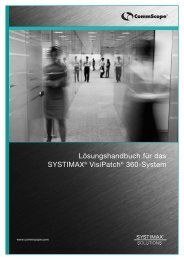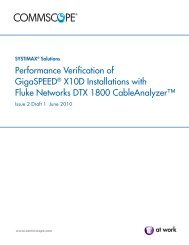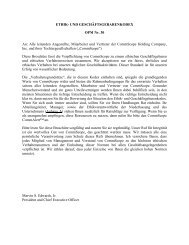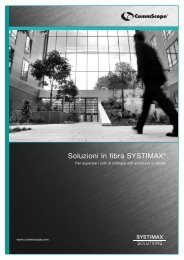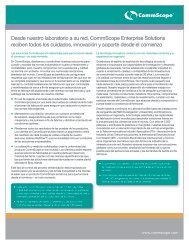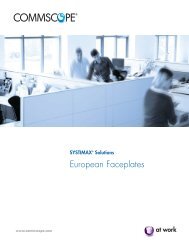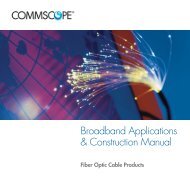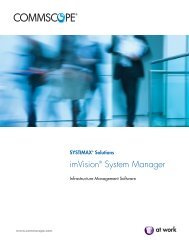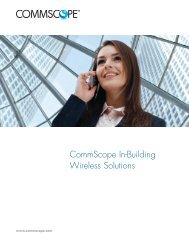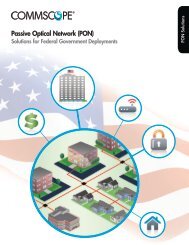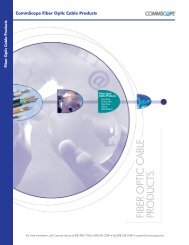CommScope® Enterprise Data Center Design Guide - Public ...
CommScope® Enterprise Data Center Design Guide - Public ...
CommScope® Enterprise Data Center Design Guide - Public ...
Create successful ePaper yourself
Turn your PDF publications into a flip-book with our unique Google optimized e-Paper software.
24<br />
www.commscope.com<br />
Applications<br />
We have tried to provide a brief overview of how different optical sources operate, but there is<br />
obviously much more to study to have a true understanding of these sources. This guide will<br />
focus more on specifically when each source is used with typical data center application.<br />
LEDs are capped at speeds of 622 Mb/s and this has limited their use to slower 10 and 100<br />
Mb/s ethernet solutions. There are some higher data rate applications like ESCON (200<br />
Mb/s) and the slowest speeds of fibre channel and ATM that could be run with LEDs over<br />
multimode fiber. Lasers do offer a high data throughput and are required for most long haul<br />
applications, but the extra cost is prohibitive for most of the short length applications found<br />
within the data center. The VCSEL hits the sweet spot of high bandwidth over a distance that<br />
covers most applications paired with a much lower component cost compared to lasers.<br />
TABLE 1: OPTICAL SOURCE APPLICATIONS<br />
Source Application Speed<br />
(Ethernet)<br />
* VCSELs will be used for 40 and 100G applications using parallel optics, where each VCSEL<br />
will support a data rate of 10 G/s or less<br />
** Lasers will be used for 40 and 100G applications using parallel optics or WDM. Each<br />
laser may provide a stream of data much higher than 10 G/s for WDM applications.<br />
Balanced Twisted Pair Applications<br />
In the data center, both optical and copper solutions are utilized, and the electronics for UPT<br />
solutions operate on a much different process. For 1000Base-T ports, the electrical signal<br />
operates over 4 copper pairs with full-duplex operation 5-Level Phase Amplitude Modulation<br />
(PAM) signaling. This is utilized to increase the amount of data transmitted with each code<br />
point. Copper ports have chips assigned to them that control the power output.<br />
Figure 7: Balanced Twisted Pair Signals<br />
Relative costs Optimal Fiber type<br />
LED 10 & 100 Mb/s low MM<br />
VCSEL 1G & 10G, and higher* medium MM<br />
LASER 1G, 10G, and higher** high SM<br />
T<br />
T<br />
T<br />
T<br />
HYBRID<br />
R R<br />
HYBRID<br />
R R<br />
HYBRID<br />
R R<br />
HYBRID<br />
R R<br />
HYBRID HYBRID HYBRID HYBRID<br />
T<br />
T<br />
T<br />
T<br />
The signal is shaped into a 1000Base-T format. Forward error correction and DSP-based<br />
(digital signal processing) adaptive filtering are used to reduce the effects of echo, cross-talk<br />
and noise.



